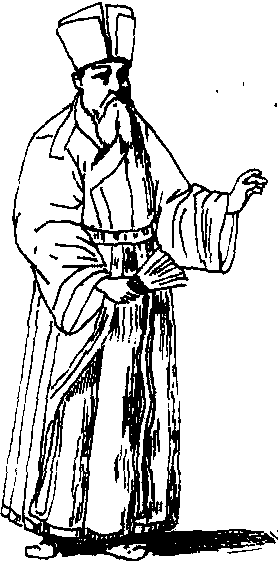080 利玛窦
16世纪末来华的耶稣会传教士。原名玛泰奥·利奇,生于意大利。他是最早向中国传播西方科学的人之一。由于他的详细介绍,李之藻著《浑盖通宪图说》两卷,内有黄道体系、星等概念,晨昏蒙影定义。著有《乾坤体义》2卷,《圜容较义》1卷,《经天谈》1卷和《坤舆万国全图》等。
利玛窦1552—1610Limadou,Matteo Ricci

明末来华的天主教耶稣会传教士。1552年10月16日出生于意大利的马塞拉塔(Macerata)城。16岁奉父命到罗马学习法律,19岁加入了耶稣会。万历九年(1581),从印度入中国传教,足迹遍布澳门、肇庆、韶州、南昌、南京等地,万历二十九年,来到北京,贿通宦官马堂,进献自鸣钟等方物,得到万历皇帝的接见。并被获许在北京建教堂布教。他兼通中外文字,著述多用中文,为了解中国文化,他苦读“四书”、“五经”,力主将天主教与中国传统的儒学理论相融合,使之能够深入人心,在中国得以广泛传播。晚年著《中国札记》一书,记述了他在中国的生活经历。介绍了中国的政治、经济、思想、地理、历史、科技以及风土人情,是欧洲第一部系统研究中国的专著。又与徐光启合译欧几里得的《几何原本》前6卷,丰富了中国几何学内容,还曾与李之藻合译过几部数学专著。又著《西字奇迹》,是第一部用罗马字注汉语音的著作。还能作画,绘耶稣圣母像,将欧洲画风传入中国。万历三十八年闰三月十九日(1610年5月11日)死于北京,葬今阜城门外二里沟。利玛窦是中西文化交流的先驱。
利玛窦
明末到中国的天主教耶稣会传教士。 字西泰。1552年生于意大利柯那省。1561年进当地的耶稣会学校就读。后赴罗马学法律。1571年入耶稣会,并在耶稣会学院攻读哲学和神学,同时钻研数学等。1578年受耶稣会派遣往印度传教。1580年升任神父。1582年奉耶稣会之命到澳门学习中文。次年随另一意大利耶稣会士罗明坚到广东肇庆定居,在中国内地建立了第一个传教会所。为适应中国的社会习俗,曾削发着僧服,自称“西僧”,并名居所为“仙花寺”。以世界地图和仿制的地球仪、日晷等招揽宾客参观,借此宣传基督教教义。发展了约80名教徒。1589年移居韶州。师从中国学者瞿太素,学习《四书》,并译成拉丁文。1594年起,改穿儒服,自称“西儒”。1595年定居南昌。完成了第一部中文宗教论著《天学实义》 (后易名《天主实义》)。1597年任耶稣会中国传教会会长,受命尽一切努力在北京开辟居留点。次年以进贡礼品、协助修正历法为由,随朝廷官员赴京。后因未获准在京居留,暂居南京。与达官名人相交往,结识李之藻、徐光启等人。1600年再度北上。次年获准向明神宗皇帝进贡圣母像、自鸣钟和世界地图等。此后定居北京,直至1610年病逝。与徐光启合译了《几何原本》前6卷、《测量法义》等。把中国的儒家经典译成拉丁文向欧洲介绍,并编写《中意葡字典》和《中国文法》供欧洲人学习汉语之用,促进了中西方文化的交流。
利玛窦1552~1610Matteo Ricci
明朝末年来中国的传教士。意大利人,曾任在华耶稣会士领袖。1582年8月7 日奉派抵达澳门。1583年陪罗明坚赴肇庆天宁寺居住传教。次年在两广总督郭应聘和肇庆知府王泮的帮助下,在肇庆城东建立教堂。为吸引民众,在教堂内公开陈列展览西洋奇器,如西洋镜、日晷、自鸣钟、三棱镜、油画圣母像等。1589年迁往韶州传教,得到来自澳门的耶稣青年会士钟鸣仁、黄明沙两人协助。此时,利玛窦实际上成为在中国内地开展传教活动的领导人和创始人。1601年到达北京,向明神宗进贡自鸣钟等礼物,获准在北京居住传教,与徐光启、李之藻等士大夫交往甚密,并与徐光启合译《几何原本》等书,向中国介绍西方自然科学知识。1610年病逝于北京。
利玛窦
明末来中国的意大利传教士。1522年10月6日生于意大利马切拉塔城。1571年加入耶稣会,1572~1576年在罗马学院学习,1577年参加赴印度传教团,1582年到达中国,1610年5月11日卒于北京。他是西学东渐的先驱。在中国用中文编译有《几何原本》(与徐光启合译》、《乾坤体义》等数学和天文学著作;编绘多种世界地图,如1584年的《山海舆地图》,1600年的《两仪玄览图》。1602年出版的《坤舆万国全图》为椭圆形五大洲图,6张图幅接合,大小为1.78m×4.14m。该图标有经纬度,表示了地圆说、气候的地带说、地表的海陆分布等。
利玛窦1552—1610MatteoRicci
最早到山东传教的耶稣会教士。意大利人。明万历二十八年(1600年),率庞迪我等八名传教士乘民船沿大运河北上,行至临清,被税使马堂扣留后关进监狱。万历二十九年(1601年)由皇帝旨准释放。1610年死于北京。